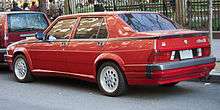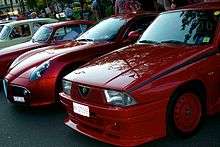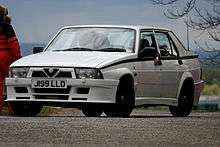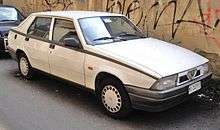Alfa Romeo 75
| Alfa Romeo 75 / Milano | |
|---|---|
.jpg) 1988 Alfa Romeo Milano Gold (US model) | |
| Overview | |
| Manufacturer | Alfa Romeo |
| Also called | Alfa Romeo Milano |
| Production | 1985-1992 |
| Assembly | Arese, Milan, Italy |
| Designer | Ermanno Cressoni at Centro Stile Alfa Romeo[1] |
| Body and chassis | |
| Class | Compact executive car (D) |
| Body style | 4-door saloon |
| Layout | Front-engine, rear-wheel-drive |
| Related |
Alfa Romeo Alfetta Alfa Romeo GTV6 Alfa Romeo SZ |
| Powertrain | |
| Engine |
1.6 L I4 (petrol) 1.8 L I4 (petrol) 1.8 L I4 (t/c petrol) 2.0 L I4 (petrol) 2.5 V6 (petrol) 3.0 V6 (petrol) 2.0 L I4 (turbodiesel) 2.4 L I4 (turbodiesel) |
| Transmission |
5-speed manual[2] 3-speed automatic[2] |
| Dimensions | |
| Wheelbase | 2,510 mm (98.8 in) |
| Length | 4,331 mm (170.5 in) |
| Width | 1,631 mm (64.2 in) |
| Height | 1,349 mm (53.1 in) |
| Curb weight | 1,100–1,300 kg (2,400–2,900 lb) |
| Chronology | |
| Predecessor | Alfa Romeo Giulietta |
| Successor | Alfa Romeo 155 |
The Alfa Romeo 75 (Tipo 161, 162B), sold in North America as the Milano, is a compact executive car produced by the Italian automaker Alfa Romeo between 1985 and 1992. The 75 was commercially quite successful: in only three years, 236,907 cars were produced,[3] and by the end of production in 1992, around 386,767 had been built.[4]
The Alfa Romeo 75 was the last model released before Alfa Romeo was acquired by Fiat. (The Alfa Romeo 164 was the last model developed independently.)
Overview
The 75 was introduced in May 1985[5] to replace the Giulietta (with which it shared many components), and was named to celebrate Alfa's 75th year of production. The body, designed by head of Alfa Romeo Centro Stile Ermanno Cressoni, was styled in a striking wedge shape, tapering at the front with square headlights and a matching grille (similar features were applied to the Cressoni-designed 33).
At the 1986 Turin Auto Salon, a prototype 75 estate was to be seen, an attractive forerunner of the later 156 Sportwagon. This version was, however, never listed for sale, being cancelled after Fiat took control of Alfa Romeo. The car, dubbed the 75 Turbo Wagon, was made by Italian coachbuilder Rayton Fissore using a 75 Turbo as the basis.[6] Two estate versions were to be found at the later 1987 Geneva Motor Show; one was this Turbo Wagon and the other was a 2.0 litre version named the Sportwagon.[7]
Technical features
The 75 featured some unusual technical features, most notably the fact that it was almost perfectly balanced from front to rear.[8] This was achieved by using transaxle schema — mounting the standard five-speed gearbox in the rear connected to the rear differential (rear-wheel drive). The front suspension was a torsion bar and shock absorber combination and the rear an expensive de Dion tube assembled with shock absorbers; these designs were intended to optimize the car's handling; moreover the rear brake discs were fitted at the centre of the rear axle, near the gearbox-differential group. The engine crankshaft was bolted directly to the two-segment driveshaft which ran the length of the underside from the engine block to the gearbox, and rotated at the speed of the engine. The shaft segments were joined with elastomeric 'doughnuts' to prevent vibration and engine/gearbox damage. The 2.0 L Twin Spark and the 3.0 Litre V6 were equipped with limited slip differential.[9]
The 75 featured a then-advanced dashboard-mounted diagnostic computer, called Alfa Romeo Control, capable of monitoring the engine systems and alerting the drivers of potential faults.
The 75 engine range at launch featured four-cylinder 1.6, 1.8 and 2.0 litre petrol carbureted engines, a 2.0 litre intercooled turbodiesel made by VM Motori,[10] and a 2.5 litre fuel injected V6. In 1986, the 75 Turbo was introduced, which featured a fuel-injected 1779 cc twin-cam engine using Garrett T3 turbocharger, intercooler and oil cooler.[11]


In 1987, a 3.0 litre V6 was added to the range and the 2.0 L Alfa Romeo Twin Cam engine was redesigned to have now two spark plugs per cylinder, the engine was named as Twin Spark. With fuel injection and variable valve timing this engine produced 148 PS (109 kW; 146 hp). This was the first production engine to use variable valve timing.[11] In North America, where the car was known as the Milano, only the 2.5 and 3.0 V6s were available, from 1987 to 1989.
The North American 2.5-litres were fundamentally different from their European counterparts. Due to federal regulations, some modifications were required. Most noticeable from the outside were the 'America' bumpers, with the typical rubber accordions in them. Furthermore, these bumpers had thick (and heavy) shock-absorbing material inside them and in addition, they were mounted to the vehicle on shock absorbers. To accommodate these shock absorbers, the 'America'-bodies were slightly different from the European ones. Other changes relative to the European model were:
- A 67-litre fuel tank which was located behind the rear seats, reducing the boot capacity from 500 L (18 cu ft) to 300 L (11 cu ft).
- Side-markers in the bumpers
- Exhaust silencer sticking out from under the bumper at the r/h side of the vehicle instead of the centre
- Reinforcements in the doors and boot lid
- Hooks underneath the bonnet, to keep the bonnet in position in a crash
The North American cars also had different equipment levels (depending on the version: Milano Silver, Milano Gold or Milano Platinum). L/h and r/h electrically adjustable outside mirrors, electrically reclining seats and cruise control were usually optional in Europe. The car was also available with a 3-speed ZF automatic gearbox option for the 2.5 V6. Other, more common options such as electrically operated rear windows and an A/C system were standard in the USA. The USA-cars also had different upholstery styles and of course different dashboard panels also indicating speed in mph, oil pressure in psi and coolant temperature in degrees F, and as a final touch the AR control was different, including a seat belt warning light.
The European-spec 2.5 V6 (2.5 6V Iniezione or 2.5QV) was officially sold only between 1985 and 1987, although some of them were not registered until 1989. Relatively few of them were sold (about 2800 units), especially when the 155 PS (114 kW; 153 hp) 1.8 Turbo got launched, which in some countries was cheaper in taxes because of its lower displacement. To create a bigger space between the V6 and the inline fours, the 2.5 was bored out to 2959 cc's to deliver 188 PS (138 kW; 185 hp) and this new engine was introduced as the 3.0 America in 1987. As its type designation suggests, the 3.0 only came in the US-specification, with the impact-bumpers and in-boot fuel tank. However, the European 'America's' were not equipped with side-markers or the door, bonnet and boot lid fortifications. Depending on the country of delivery, the 3.0 America could be equipped with a catalytic converter.
In 1988 engines were updated again, the 1.8 L carburetor version was replaced with fuel injected 1.8 i.e. and new bigger diesel engine was added to the range. In the end of 1989 the 1.6 L carburetor version was updated to have fuel injection and 1990 the 1.8 L turbo and 3.0i V6 got some more power and updated suspension. The 3.0 V6 was now equipped with a Motronic system instead of an L-Jetronic. The 1.8L turbo was now also available in 'America'-spec, but strangely enough not available for the USA market. The 3.0 V6 did make it to the United States, and was sold as Milano Verde.[11]
| Model | Units produced |
|---|---|
| 1.6 | 99.522 |
| 1.6 IE | 27.989 |
| 1.8 | 45.138 |
| 1.8 IE | 48.270 |
| 1.8 Turbo/America/Q.V. | 6.536 |
| 2.0 | 18.971 |
| 2.0 Twin Spark | 57.084 |
| 2.5 6v Q.V/Milano | 12.611 |
| 3.0 V6/America/Q.V./ | 6.753 |
| 2.0 TD | 46.273 |
| 2.4 TD | 6.110 |
| Total | 375.257 |
Turbo Evoluzione


500 examples of the Turbo Evoluzione were produced in spring 1987 to meet Group A requirements.[12] The car had many modifications compared to the normal turbo model. The engine was down-sleeved to 1,762 cc (normally 1,779 cc) and while the claimed power is the same as in the standard turbo, this engine is better suited for power upgrades than the standard 75 Turbo engine.[13]
Engines

| Model | Engine | Displacement | Fuel system | Power | Torque | Note |
|---|---|---|---|---|---|---|
| Launch, May 1985 | ||||||
| 1.6 | I4 | 1,570 cc | Carb | 110 PS (81 kW) at 5,800 rpm | 146 N·m (108 lb·ft) at 4,000 rpm | - |
| 1.8 | I4 | 1,779 cc | Carb | 120 PS (88 kW) at 5,300 rpm | 170 N·m (125 lb·ft) at 4,000 rpm | - |
| 2.0 | I4 | 1,962 cc | Carb | 128 PS (94 kW) at 5,400 rpm | 183 N·m (135 lb·ft) at 4,000 rpm | - |
| 2.0 TD | I4 | 1,995 cc | Turbodiesel | 95 PS (70 kW) at 4,300 rpm | 192 N·m (142 lb·ft) at 2,300 rpm | left hand drive markets only |
| 2.5 | V6 | 2,492 cc | Injected V6 | 156 PS (115 kW) at 5,600 rpm | 206 N·m (152 lb·ft) at 3,200 rpm | - |
| 1986 | ||||||
| 1.8 Turbo | I4 | 1,779 cc | Injected Turbo | 155 PS (114 kW) at 5,800 rpm | 226 N·m (167 lb·ft) at 2,600 rpm | - |
| 1987 | ||||||
| 1.8 Turbo EVOLUZIONE | I4 | 1.762 cc | Injected Turbo | 155 PS (114 kW) at 5,800 rpm | 226 N·m (167 lb·ft) 2600 rpm | - |
| 2.0 TS | I4 | 1,962 cc | Injected | 148 PS (109 kW) at 5,800 rpm | 186 N·m (137 lb·ft) at 4,000 rpm | upgrade of existing 2.0 engine |
| 3.0 | V6 | 2,959 cc | Injected | 188 PS (138 kW) at 5,800 rpm | 250 N·m (184 lb·ft) at 3,000 rpm | in North American market "Milano Verde" only |
| 1988 | ||||||
| 1.6 catalytic | I4 | 1,570 cc | Injected | 105 PS (77 kW) at 6,000 rpm | 132 N·m (97 lb·ft) 4000 rpm | - |
| 1.8 i.e. | I4 | 1,779 cc | Injected | 122 PS (90 kW) at 5,500 rpm | 157 N·m (116 lb·ft) at 4,000 rpm | replacing existing 1.8 |
| 2.4 TD | I4 | 2,393 cc | Turbodiesel | 112 PS (82 kW) at 4,200 rpm | 235 N·m (173 lb·ft) at 2,400 rpm | - |
| 3.0 V6 America catalytic | V6 | 2,959 cc | Injected | 188 PS (138 kW) at 5,800 rpm | 250 N·m (184 lb·ft) at 3,000 rpm | Europe market only |
| 1990 | ||||||
| 1.6 i.e. | I4 | 1,570 cc | Injected | 107 PS (79 kW) at 6,000 rpm | 137 N·m (101 lb·ft) at 4,000 rpm | - |
| 1.8 Turbo Quadrifoglio Verde | I4 | 1,779 cc | Injected Turbo | 165 PS (121 kW) at 5,800 rpm | 226 N·m (167 lb·ft) 2600 rpm | - |
| 2.0 TS catalytic | I4 | 1,962 cc | Injected | 148 PS (109 kW) at 5,800 rpm | 186 N·m (137 lb·ft) 4000 rpm | replacing existing 2.0 |
| 3.0 V6 QV | V6 | 2,959 cc | Injected | 192 PS (141 kW) at 5,800 rpm | 250 N·m (184 lb·ft) at 3,000 rpm | replacing the existing 3.0, this motor from the 164 featuring a Motronic system as opposed to the earlier L-Jetronic. This model was known as the "Potenziata" |
Motorsports

Alfa Romeo and its racing department Alfa Corse raced the 75 Turbo Group A in the World Touring Car Championship in 1987 season. There were six official entries, two run directly by Alfa Corse, two by Brixia Corse, one for Albatech and one for Swedish team Q-Racing. Team drivers included Formula One drivers such as Nicola Larini, Gabriele Tarquini, Alessandro Nannini, Jacques Laffite and Mario Andretti as well as World Sportscar champion Jean-Louis Schlesser.[14] A Class 2 car with enough power (approximately 320 bhp (239 kW; 324 PS)) which should have seen the cars on par with the new and more track focused BMW M3s, the Alfa's had very little success in the WTCC, and with the whole season descending into a political farce, Alfa Romeo team boss Cesare Fiorio shut down the team before the overseas races.[15]
Australian driver Colin Bond, winner of the 1975 Australian Touring Car Championship and 1969 Hardie-Ferodo 500, had been racing the GTV6 model since 1984 and stayed loyal to Alfa Romeo, running a Caltex sponsored Alfa 75 in the 1987 Australian Touring Car Championship to replace the GTV6. Bond's new 75 was built by the Italian Luigi team, but Bond found the engine it came with only produced about 200 bhp (149 kW; 203 PS) instead of the 320 bhp it should have. This saw him finish a distant 9th place in the championship while the team's engine builder, Melbourne based Alfa expert tuner Joe Beninca, tried to claw back the extra power. This was achieved after the car was converted to right hand drive which allowed an exhaust system to be fitted that didn't wind its way around the steering rack. Bond also drove the end of season endurance races which included the Bathurst round of the WTCC. After Bond qualified the car in 21st, co-driver Lucio Cesario destroyed the front of the 75 in a crash at the top of the mountain on lap 34 of the race which forced the cars withdrawal from the Calder Park and Wellington rounds of the WTCC. The car was repaired in time for the Australian Grand Prix support races in Adelaide where Bond qualified a fine second and finished 5th in the race in the cars 'down under' swansong as Bond, the only driver to embrace the 75 in Australia, switched to race the all-conquering Ford Sierra RS500 from 1988 in a bid to return to the winners circle.
Gianfranco Brancatelli won the 1988 ITC serie with Alfa 75 Turbo and Giorgio Francia placed second in the 1991 ITC.[16] The 9th Giro d'Italia (Automobile) in 1988 was won by the team of Miki Biasion, Tiziano Siviero and Riccardo Patrese with a 75 Turbo Evoluzione IMSA.[17] A 75 Turbo Evoluzione IMSA also won the 10th Giro d'Italia (Automobile) in 1989.
The British Alfa Romeo Dealer Team ran a pair of cars in the 1986-87 seasons with drivers Rob Kirby and John Dooley. Initially the team raced the V6 version of the 75 alongside their older GTV6 before upgrading to the 75 turbo. While a match for pace in Class B with the Ford Escort RS turbos, once Frank Sytner's BMW M3 appeared they were rendered uncompetitive.
References
- ↑ "Designer". ajovalo.net. Retrieved 2012-02-08.
- 1 2 "Alfa Romeo 75". carsfromitaly.net. Archived from the original on 31 July 2007. Retrieved 2007-08-07.
- ↑ "The 75". www.alfaromeo75.it (in Italian). Retrieved 2007-08-04.
- ↑ "Alfa Romeo 75". www.alfaromeo75.it. Retrieved 2007-08-04.
- ↑ "Alfa Romeo 75". www.omniauto.it (in Italian). Archived from the original on 5 August 2007. Retrieved 2007-08-04.
- ↑ "Production Specials". alfa75.info. Archived from the original on 2007-04-02. Retrieved 2007-06-25.
- ↑ "Giardinetta, Promiscua e Sportwagon" (in Russian). alfisti.ru. Archived from the original on 8 June 2007. Retrieved 2007-06-25.
- ↑ "1985 Alfa Romeo 75". conceptcarz.com. Retrieved 2007-08-07.
- ↑ "Alfa Romeo 75". alfaworkshop.co.uk. Archived from the original on 8 August 2007. Retrieved 2007-08-07.
- ↑ "Automotive/Past Vehicles/Alfa Romeo". vmmotori.it. Retrieved 2007-08-07.
- 1 2 3 "News 17.10.2005". italiaspeed.com. Archived from the original on 8 August 2007. Retrieved 2007-08-07.
- ↑ "Alfa Romeo 75 Turbo Evoluzione". alfisti.net. Retrieved 2007-06-25.
- ↑ "Alfa 75 Evoluzione". alfaromeo75.it (in Italian). Retrieved 13 October 2012.
- ↑ "T H E R A C I N G". homdrum.net. Retrieved 2007-08-07.
- ↑ "World Touring Car Championship". homepage.mac.com. Archived from the original on 18 April 2009. Retrieved 2009-04-21.
- ↑ "Alfa75 ITC Competition History". www.alfa75.info. Archived from the original on 2007-06-23. Retrieved 2007-08-07.
- ↑ "Miki Biasion". worldrally.altervista.org (in Italian). Retrieved 2010-10-01.
External links
| Wikimedia Commons has media related to Alfa Romeo 75. |
- Alfa Romeo Bulletin Board & Forums
- Alfa Romeo 75 / Milano enthusiasts International Web & SCARB Register
- Alfa Romeo Milano Registry
- UK based but worldwide forum for 75 owners
- Alfa GTV6 website and forum that also caters for 75 owners
| « previous — Alfa Romeo car timeline, 1980s–present | |||||||||||||||||||||||||||||||||||||
|---|---|---|---|---|---|---|---|---|---|---|---|---|---|---|---|---|---|---|---|---|---|---|---|---|---|---|---|---|---|---|---|---|---|---|---|---|---|
| Type | 1980s | 1990s | 2000s | 2010s | |||||||||||||||||||||||||||||||||
| 0 | 1 | 2 | 3 | 4 | 5 | 6 | 7 | 8 | 9 | 0 | 1 | 2 | 3 | 4 | 5 | 6 | 7 | 8 | 9 | 0 | 1 | 2 | 3 | 4 | 5 | 6 | 7 | 8 | 9 | 0 | 1 | 2 | 3 | 4 | 5 | 6 | |
| Supermini | MiTo | ||||||||||||||||||||||||||||||||||||
| Small family car | Arna | 145 | |||||||||||||||||||||||||||||||||||
| Alfasud | 33 | 146 | 147 | Giulietta (940) | |||||||||||||||||||||||||||||||||
| Compact executive car | Giulietta (116) | 75/Milano | 155 | 156 | 159 | Giulia (952) | |||||||||||||||||||||||||||||||
| Executive car | Alfetta | 90 | 164 | 166 | |||||||||||||||||||||||||||||||||
| Alfa 6 | |||||||||||||||||||||||||||||||||||||
| Coupé | Sprint | GT | |||||||||||||||||||||||||||||||||||
| GTV and GTV6 | GTV (916) | Brera | |||||||||||||||||||||||||||||||||||
| Spider | Spider (105/115) | Spider (916) | Spider (939) | ||||||||||||||||||||||||||||||||||
| Sports car | SZ | 8C Competizione | 4C | ||||||||||||||||||||||||||||||||||
| RZ | 8C Spider | 4C Spider | |||||||||||||||||||||||||||||||||||
| Crossover SUV | Stelvio | ||||||||||||||||||||||||||||||||||||
| Racing car | 179/182/183T/ |
GTV, GTV6 | 75 Turbo | SZ Trophy | 155 GTA 155 V6 TI |
GTV Cup | 156 D2/ GTA S2000 |
147 Cup 147 GTA Cup |
|||||||||||||||||||||||||||||
| LCV | F11/F12/A11/A12 | AR6 | |||||||||||||||||||||||||||||||||||
| AR8 | |||||||||||||||||||||||||||||||||||||
